1993 BUICK RIVIERA mirror
[x] Cancel search: mirrorPage 101 of 324
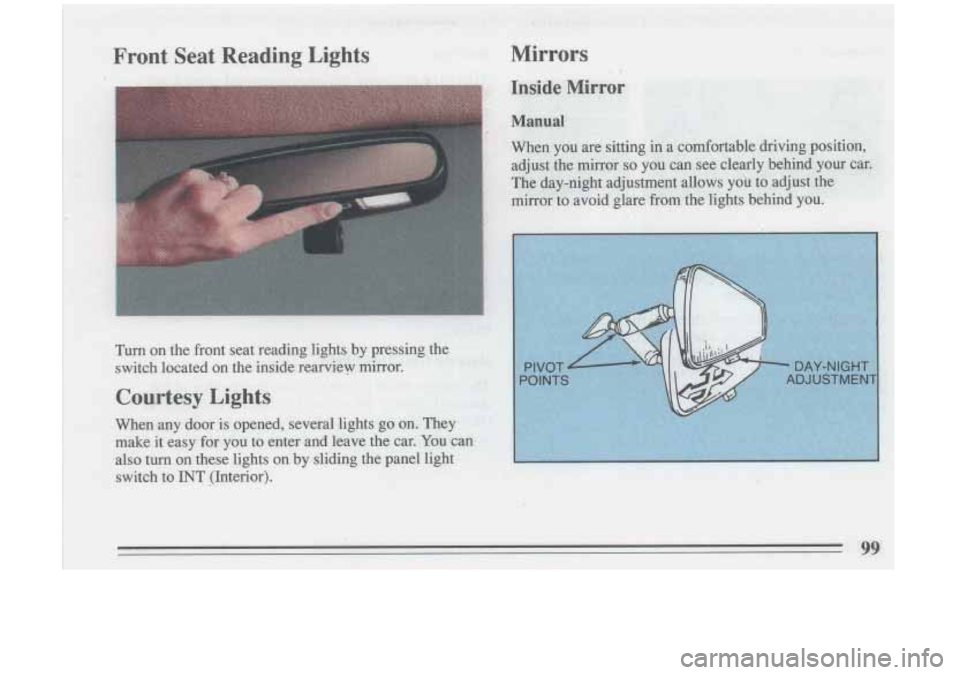
', ,> I
Mirrors
Page 102 of 324
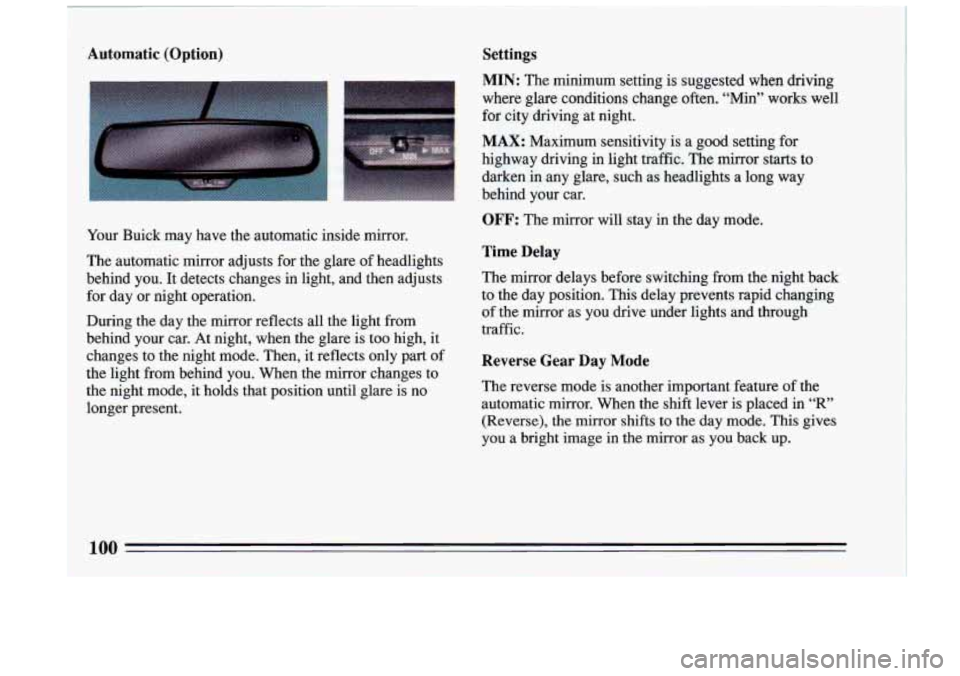
Automatic (Option) Settings
Your Buick may have the automatic inside mirror.
The automatic mirror adjusts for the glare of headlights
behind you.
It detects changes in light, and then adjusts
for day or night operatiol-~
During the day the mirror reflects all the light from
behind your car. At night, when the glare is too high, it
changes to the night mode. Then,
it reflects only part of
the light from behind you. When the mirror changes to
the night mode, it holds that position until glare is no
longer present.
MIN: The minimum setting is suggested when driving
where glare conditions change
often. '"in" works well
for city driving at night.
MAX: Maximum sensitivity is a good setting for
highway driving in light traffic. The mirror
starts to
darken in any glare, such as headlights a long way
behind your car.
OFF: The mirror will stay in the day mode.
Time Delay
The mirror delays before switching from the night back
to the day position.
This delay prevents rapid changing
of the mirror as you drive under lights and through
traffic.
Reverse Gear Day Mode
The reverse mode is another important feature of the
automatic mirror. When the shift lever is placed in
"R"
(Reverse), the mirror shifts to the day mode. This gives
you a bright image in the mirror as you back up.
I
100
Page 103 of 324
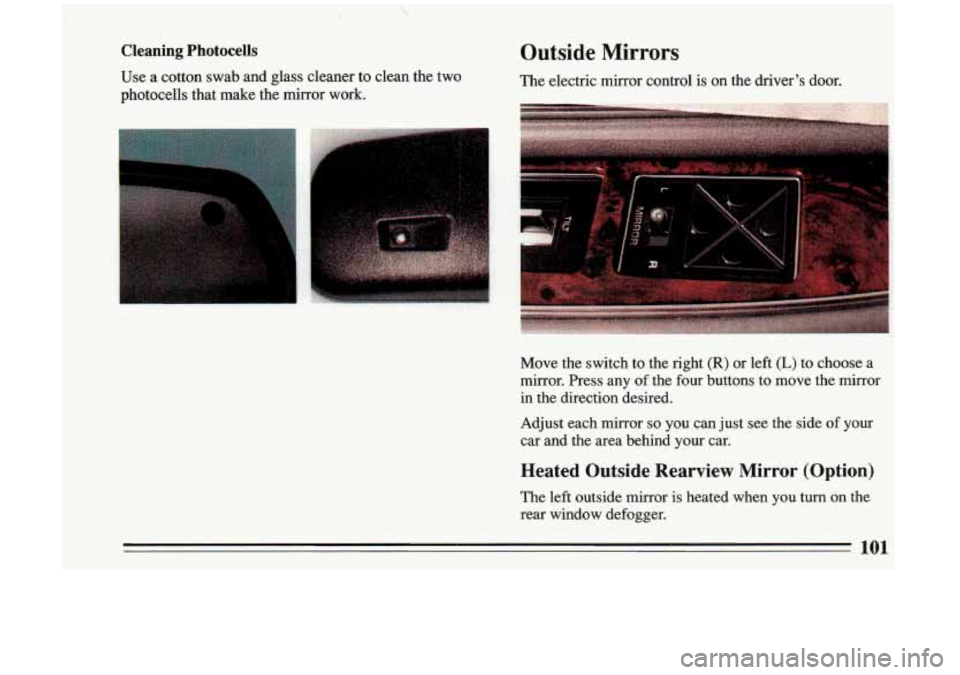
Cleaning Photocells
Use a cotton swab and glass cleaner to clean the two
photocells that make the mirror work.
Outside Mirrors
The electric mirror control is on the driver's door.
Move the switch to the right
(R) or left (L) to choose a
mirror. Press any
of the four buttons to move the mirror
in the direction desired.
Adjust each mirror
so you can just see the side of your
car and the area behind your car.
Heated Outside Rearview Mirror (Option)
The left outside mirror is heated when you turn on the
rear window defogger.
101
Page 104 of 324
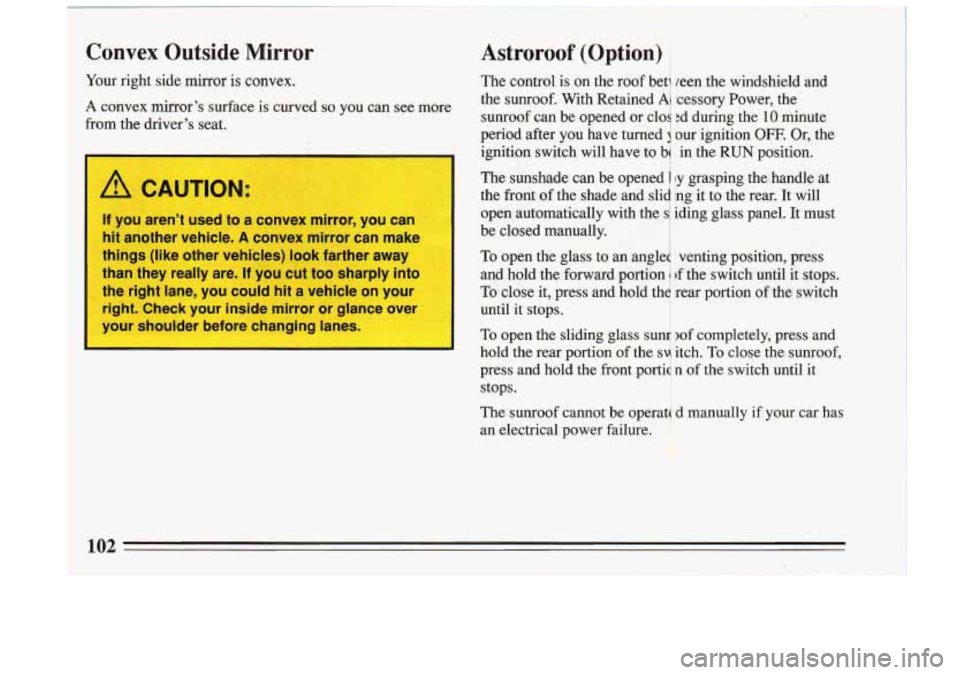
Iur
COI
)m right side mirror
is convex.
nvex
mirror's surface is curved
the driver's seat. so you can see more
/!1 CAUTION:
If you aren't used to a convex mirror, you can
hit another vehicle.
A convex mirror can make
things (like other vehicles) look farther away
than they really are.
If you cut too sharply into
the right lane,
you could hit a vehicle on your
right. Check your inside mirror or glance over
your shoulder before changing lanes.
i
Astroroof (Option)
The control is on the roof bet1 leen the windshield and
the sunroof. With Retained
Ai lcessory Power, the
sunroof can be opened or cloq ;d during the
10 minute
period after you have turned our ignition
OFF. Or, the
ignition switch will have to b
in the RUN position.
The sunshade can be opened 1 !y grasping the handle at
the ffont
of the shade and slid ing it to the rear. It will
open automatically with the iding..glass panel. It must
be closed manually. I
To open the glass to an angled venting position, press
and hold the forward portion
1 rf the switch until it stops.
To close it, press and hold th$ rear Eortion of the switch
until it stops.
I"'%+ -. .
To open the sliding glass sund 2of completely, press and
hold the rear portion of the
svi itch. To close the sunroof,
press and hold the front portia
n of the switch until it
stops.
The sunroof cannot be operata
d manually if your car has
an electrical power failure.
I. '~."-,"l,~~ :. - ,
*;e -c
102 -
Page 125 of 324
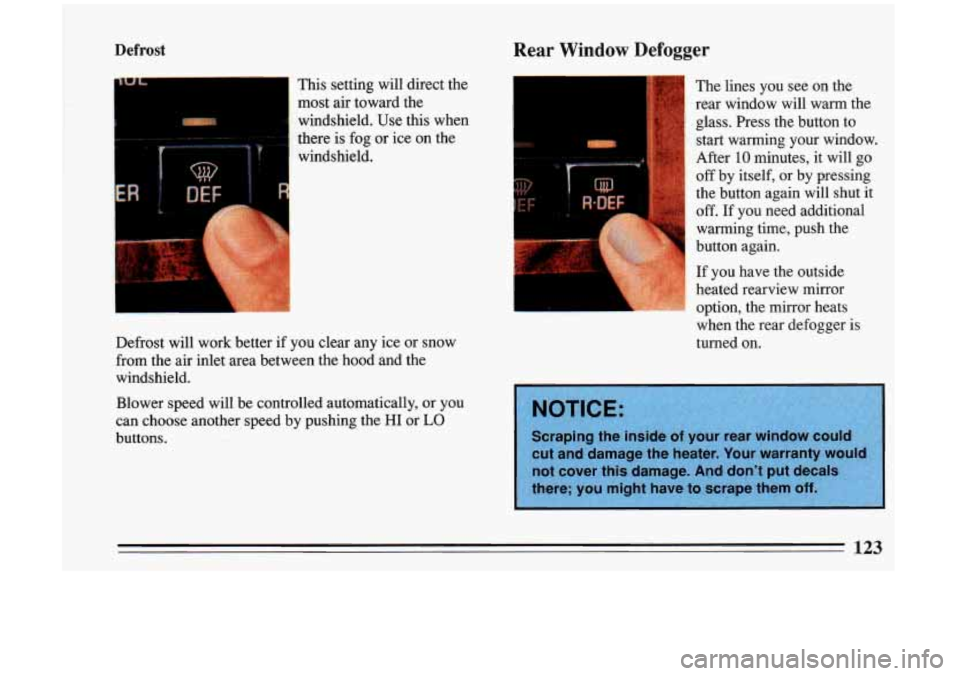
Defrost
This setting will direct the
most air toward the
windshield. Use this when
there is fog
or ice on the
Rear Window Defogger
f
windshield.
Defrost will work better if you clear any ice or snow
from the air inlet area between the hood and the
windshield.
Blower speed will be controlled automatically, or you
can choose another speed by pushing the HI
or LO
buttons. The
lines you see
on the
rear window will warm the
glass. Press the button to
start warming your window.
After
10 minutes, it will go
off by itself, or by pressing
the button again will shut it
off. If you need additional
warming time, push the
button again.
If you have the outside
! heated rearview mirror option, the mirror heats
when the rear defogger is
turned on.
Page 164 of 324
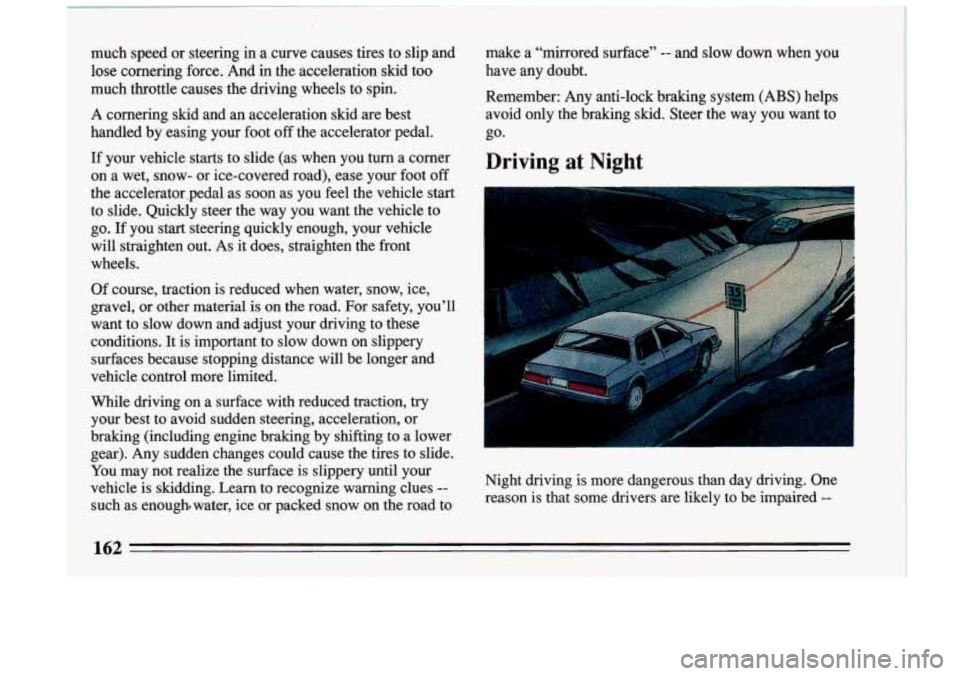
much speed or steering in a curve causes tires to slip and
lose cornering force. And in the acceleration skid too
much throttle causes the driving wheels to spin.
A cornering skid and an acceleration skid are best
handled by easing your foot
off the accelerator pedal.
If your vehicle starts to slide (as when you turn a corner
on a wet, snow- or ice-covered road), ease your foot
off
the acceleratorpedal as soon as you feel the vehicle start
to slide. Quickly steer the way you want the vehicle to go. If you
start steering quickly enough, your vehicle
will straighten out.
As it does, straighten the front
wheels.
Of course, traction is reduced when water, snow, ice,
gravel,
or other material is on the road. For safety, you’ll
want to slow down and adjust your driving to these
conditions. It is important to slow down on slippery
surfaces because stopping distance will be longer and
vehicle control more limited.
While driving on a surface with reduced traction,
try
your best to avoid sudden steering, acceleration, or
braking (including engine braking by shifting to a lower
gear). Any sudden changes could cause the tires to slide.
You may not realize the surface is slippery until your
vehicle is skidding. Learn to recognize warning clues
--
such as enoughewater, ice or packed snow on the road to make
a “mirrored surface” -- and slow down when you
have any doubt.
Remember: Any anti-lock braking system
(ABS) helps
avoid only the braking skid. Steer the way you want to
go.
Driving at Night
Night driving is more dangerous than day driving. One reason
is that some drivers are likely to be impaired --
162
I
Page 165 of 324
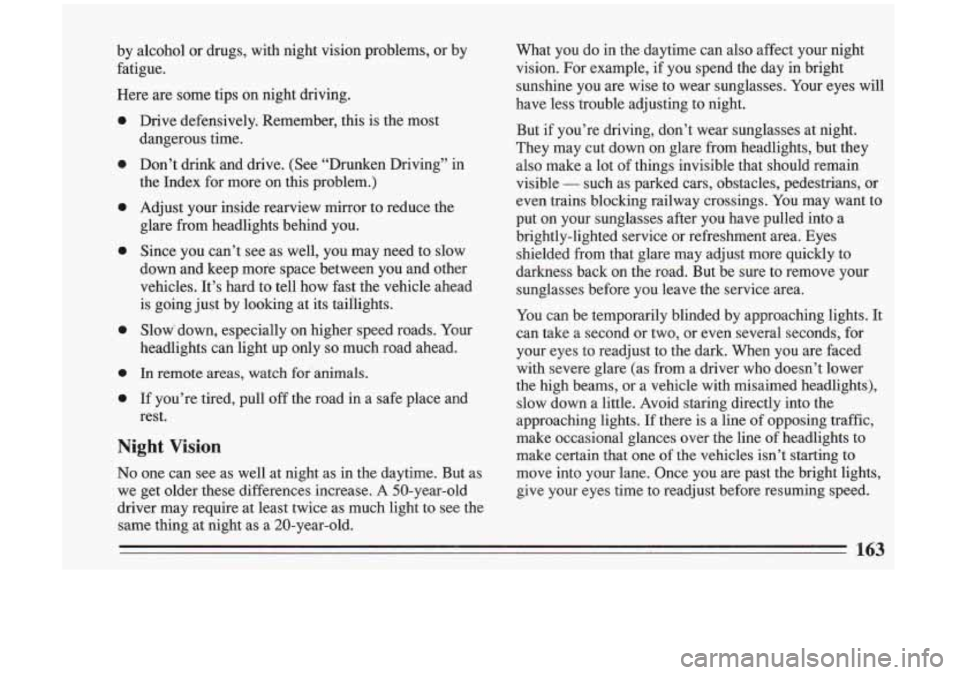
by alcohol or drugs, with night vision problems, or by
fatigue.
Here are some tips on night driving.
0
0
0
0
0
0
0
Drive defensively. Remember, this is the most
dangerous time.
Don’t drink and drive. (See “Drunken Driving” in
the Index for more on this problem.)
Adjust your inside rearview mirror to reduce the
glare
from headlights behind you.
Since you can’t see as well, you may need to slow
down and keep more space between you and other
vehicles. It’s hard to tell how fast the vehicle ahead
is going just by looking at its tail’lights.
Slow’’ down, especially on higher speed roads. Your
headlights can light up only
so much road ahead.
In remote areas, watch for’animals.
If you’re tired, pull off the road in a safe place and
rest.
Night Vision
No one can see as well at night as in the daytime. But as
we get older these differences increase. A 50-year-old
driver may require at least twice as much light to see the
same thing at night as a 20-year-old. What you
do in the daytime can also affect your night
I
vision. For example, if you spend the day in bright
sunshine you are wise to wear sunglasses. Your eyes will
have less trouble adjusting to night.
But if you’re driving, don’t wear sunglasses at night.
They may cut down on glare from headlights, but they
also make a lot of things invisible that should remain
visible
- such as parked cars, obstacles, pedestrians, or
even trains blocking railway crossings. You may want to
put on your sunglasses after you have pulled into a
brightly-lighted service or refreshment area. Eyes
shielded from that glare may adjust more quickly to
darkness back on the road. But be sure to remove your
sunglasses before you leave the service area.
You can be temporarily blinded by approaching lights. It
can take a second or two, or even several seconds, for
your eyes
to readjust to the dark. When you are faced
with severe glare (as from a driver who doesn’t lower
the hi.gh beams, or a vehicle with misaimed headlights),
slow down a little. Avoid staring directly into the
approaching lights.
If there is a line of opposing traffic,
make occasional glances over the line of headlights to
make certain that one of the vehicles isn’t starting to
move into your lane. Once you are past the bright lights,
give
your eyes time to readjust before resuming speed.
163 ,
Page 172 of 324
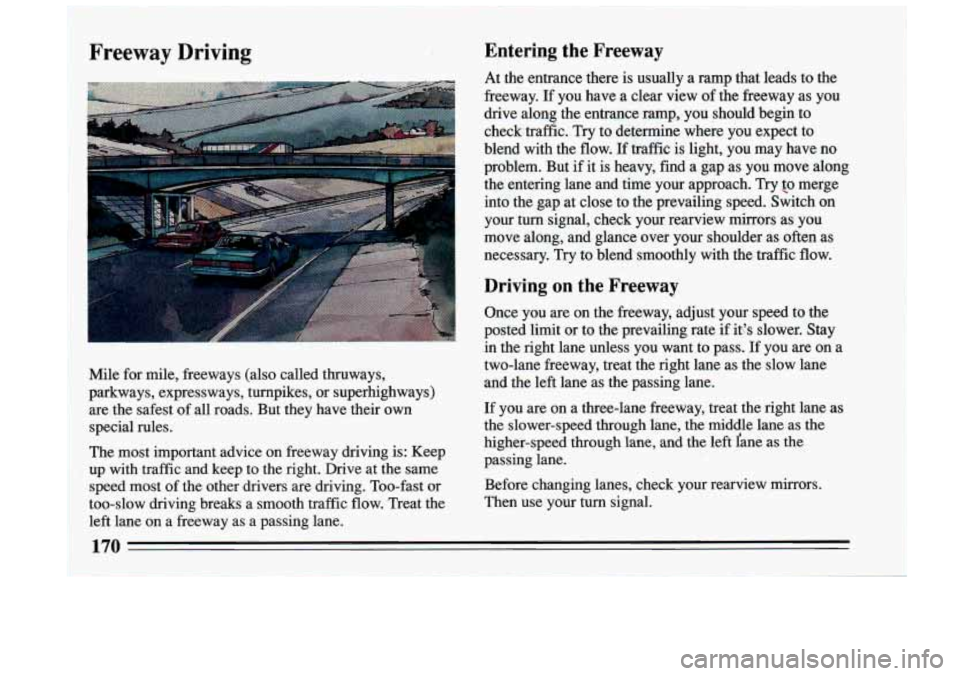
'Freeway Driving Entering the Freeway
the entering lane and time your approach. Try lo merge
into the gap at close to the prevailing speed. Switch on
your turn signal, check your rearview mirrors as you
move along, and glance over your shoulder as often as
necessary.
Try to blend smoothly with the traffic flow.
Driving on the Freeway
Once.you are on the freeway, adjust your speed to the
posted limit or to the prevailing rate if it& slower. Stay
in the right lane unless you want to pass.
If you are on a
two-lane freeway, treat the right lane as the slow lane
and the left lane as the passing lane.
If you are on a three-lane freeway, treat the right lane as
the slower-speed through lane, the middle lane as the
higher-speed through lane, and the left fane as the
passing lane.
Before changing lanes, check your rearview mirrors.
Then use your
turn signal.
Mile for mile, freeways (also called thruways,
parkways, expressways, turnpikes, or superhighways) are the safest of all roads. But they have their own
special rules.
The most important advice on freeway driving is: Keep up with traffic and keep to the right. Drive at the same
speed most of the other drivers are driving. Too-fast 'or
too-slow driving breaks a smooth traffic flow. Treat the
left lane on a freeway as a passing lane.
170